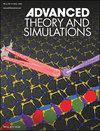Modeling Electrical Transport in Random Networks Composed of Metal-Oxide Nanowires: The Transition from Junction-Dominated to Nanowire-Dominated Regime
IF 2.9
4区 工程技术
Q1 MULTIDISCIPLINARY SCIENCES
引用次数: 0
Abstract
Random networks of metal oxide nanowires are of great technological interest in a variety of applications. Unveiling how the properties of the elementary components of the network, namely, nanowires and nanowire-nanowire junctions, may emerge as macroscopic functionalities is a fundamental issue. However, the disordered nature of the network and difficulties in estimating important properties, such as the junction contact radius, hinder the understanding and exploitation of these materials. This paper develops a model suitable for discussing the electrical resistance of the network and its transition from the junction-dominated regime to the nanowire-dominated regime, based on the nanowire characteristic lengths and energies. The result is achieved by integrating recent network theories with the equations of semiconducting metal oxides. Constraints imposed by the thermodynamics of contact mechanics are introduced to provide a lower limit for the unknown junction contact radius. Focusing on the literature of gas sensing, the model provides a theoretical background to frame the relationship between gas-sensing properties and the surface termination of nanowires in the context of network theories.

由金属氧化物纳米线组成的随机网络中的电传输建模:从结主导到纳米线主导的转变
金属氧化物纳米线的随机网络具有广泛的应用前景。揭示网络的基本组成部分(即纳米线和纳米线-纳米线结)的特性如何以宏观功能出现是一个基本问题。然而,网络的无序性质和难以估计的重要性质,如结接触半径,阻碍了这些材料的理解和开发。本文建立了一个基于纳米线特征长度和能量的模型,用于讨论网络的电阻及其从结主导状态到纳米线主导状态的转变。该结果是通过将最新的网络理论与半导体金属氧化物的方程相结合而得到的。通过引入接触力学热力学约束,给出了未知结点接触半径的下限。该模型着眼于气体传感的文献,为在网络理论的背景下构建气体传感特性与纳米线表面终止之间的关系提供了理论背景。
本文章由计算机程序翻译,如有差异,请以英文原文为准。
求助全文
约1分钟内获得全文
求助全文
来源期刊

Advanced Theory and Simulations
Multidisciplinary-Multidisciplinary
CiteScore
5.50
自引率
3.00%
发文量
221
期刊介绍:
Advanced Theory and Simulations is an interdisciplinary, international, English-language journal that publishes high-quality scientific results focusing on the development and application of theoretical methods, modeling and simulation approaches in all natural science and medicine areas, including:
materials, chemistry, condensed matter physics
engineering, energy
life science, biology, medicine
atmospheric/environmental science, climate science
planetary science, astronomy, cosmology
method development, numerical methods, statistics
 求助内容:
求助内容: 应助结果提醒方式:
应助结果提醒方式:


